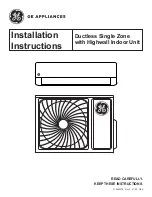
– 80 –
– 8 –
EN
Cleaning the indoor unit and
remote control
• Ask qualified service person to clean the indoor units
for the models listed in the warning on the top of this
chapter.
• Wipe with a dry, soft cloth.
• Do not use benzine, thinner, scouring powder,
chemical cloth, etc. as those may cause deformation
or breakage.
If unused for over a month
• Leave the fan on for half a day or so to dry the inside.
• Turn off the main power switch.
• Clean the air filter and then attach it.
Periodic inspection
• After being used for a long period of time, the parts
may deteriorate or malfunction, or the drainage may
worsen, due to heat, moisture, dust, or general
usage.
• In addition to the maintenance, it is recommended
that you have a inspection (charges apply)
performed by the dealer where you purchased the
unit, etc.
Before the cooling / heating
season
Ask a qualified service person to clean the drain
pan.
CAUTION
Clean the drain pan
Without cleaning, the drain pan may be filled with waste,
and water may overflow onto the ceiling or floor.
9
Troubleshooting
When the following symptoms are found, check the points described below before asking repair servicing.
Symptom
Cause
It
is
no
t a
f
a
ilu
re
.
Outdoor unit
• White misty cold air or water
is out.
• Fan of the outdoor unit stops automatically and performs defrost
operation.
• Sometimes, noise of air
leak is heard.
• Solenoid valve works when defrost operation starts or finishes.
Indoor unit
• “Swish” sound is heard
sometimes.
• When the operation has started, during the operation, or immediately after
the operation has stopped, a sound such as water flows may be heard,
and the operation sound may become larger for 2 or 3 minutes
immediately after the operation has started.
They are flowing sound of refrigerant or draining sound of dehumidifier.
• Slight clacking sound is
heard.
• This is sound generated when heat exchanger, etc. expand and contract
slightly due to change of temperature.
• “
” indication is lit.
• When cooling operation cannot be performed because another indoor unit
performs heating operation.
• Is outdoor temperature out of operation temperature range?
• “
” indication is lit.
• When the manager of the air conditioner has fixed the operation to COOL
or HEAT, and an operation contrary to the setup operation is performed.
• “
” indication is lit.
• When stopping the fan to prevent cool air blow at starting heating.
• Sound or cool air is output
from the stand by indoor
unit.
• Since refrigerant is flowed temporarily to prevent stay of oil or refrigerant
in the stand by indoor unit, sound of flowing refrigerant, may be heard or
white steam when other indoor unit operates in HEAT mode, and cold air
in COOL mode may be blow-out.
• When power of the air conditioner is
turned on, “Ticktock” sound is heard.
• Sound is generated when the expansion valve operates when power has
been turned on.
• LCD blurs when it is touched.
• LCD may temporarily blur by static electricity.
Ch
ec
k a
g
ain
.
Operates or stops automatically.
• Is the timer “ON” or “OFF”?
Does not operate.
• Is it a power failure?
• Is the power switch turned off?
• Is the power fuse or breaker blown?
• Has the protective device operated? (The operation lamp goes on.)
• Is the timer “ON”? (The operation lamp goes on.)
• Are COOL and HEAT selected simultaneously?
(“
” indication is lit on the display of the remote control.)
• Is the outside air temperature outside of operating temperature range?
The operation is automatically stopped (“
” on the remote control display
turns on).
If only fan operation is performed:
• Is the outside air temperature outside of operating temperature range for
cooling and heating? The operation is automatically switched to the fan
mode.
15-EN
16-EN
















































